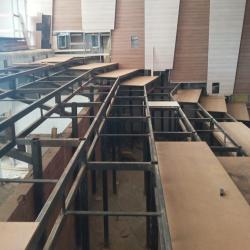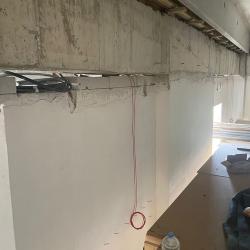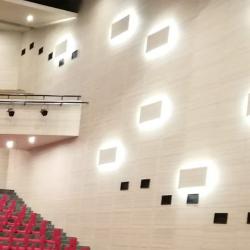Ground Raising
Raised Flooring in Conference Hall Construction
We've been building conference halls for years, and in every project, I always hear the same question: “Can we just leave the floor flat?” My answer is clear: if you want clear visibility of the stage, the floor cannot remain flat. Raised flooring is not just about aesthetics; it’s a functional necessity.
If you want the audience to clearly see the stage, and for those in the back rows to enjoy the experience as much as those in the front, the seating area must be elevated in steps. Especially in large halls, if this issue is ignored, even the most comfortable chairs won’t save the day. Let me give you an example: in a university project last year, we did a trial run on a flat surface, but the last 6 rows couldn’t see the stage. Once the floor was raised, the difference was like night and day.
Which Halls Require Raised Flooring?
Is raised flooring necessary for every hall? No. But in conference halls, theaters, cinemas, or multi-purpose auditoriums, this application is essential. Especially in halls seating more than 80 people, a solution without elevation greatly reduces audience satisfaction. It can also be applied in smaller halls, but we usually recommend it for seating arrangements of more than 5 rows.
We worked on a municipal hall with 150 seats. In the existing setup, all seats were on a flat floor. The back rows could only see the stage via a projector screen. We redesigned the floor with a three-level elevation. The result? Same chairs, same hall—but the viewing experience was completely transformed. Attendees were finally able to make eye contact with the stage.
Implementation Methods and Material Selection
There are two main methods we use for raised flooring: metal frame systems and wooden frame systems. Which one we choose depends on the hall size, load requirements, and budget. For institutional halls, we generally prefer metal frames due to their durability. OSB or plywood panels are laid over the frame, followed by the floor finish.
Wooden frames are more affordable but in large halls, they may creak or flex over time. That's why we inspect the hall first, then provide a technical report explaining the advantages of each material in detail.
For floor finishing, we offer options like carpet, PVC, or acoustic carpet tiles. It’s not just about looks—acoustics and reflection factors are also taken into account.
Installation Process and Key Considerations
Raised flooring is the backbone of the hall. You can’t install chairs without it. First, we measure floor levels and determine height differences. Then we begin assembling the frame. The standard height between tiers is about 15–18 cm, allowing viewers to see the stage comfortably without feeling steep.
One of our top priorities during installation is vibration control. If the structure is not solid, the entire platform may shake as people move. To prevent this, we secure connection points with special anchors and reinforce the frame with intermediate supports when needed.
Once the work is done, we test every step. We walk on it, jump, carry equipment—every aspect is tested before final delivery.
Impact on Acoustics and Sightlines
The purpose of raised flooring isn’t just visibility. It also improves sound distribution. A sloped floor helps the sound reach the back rows more effectively. So, not just those in the front, but everyone can hear the speaker clearly.
In a recent project for a government agency, we combined acoustic panels with raised flooring. Before, the hall suffered from echo problems. After the intervention, it had the ambiance of a professional conference hall. Sound became more balanced—an essential factor for seminars and speaking engagements.
Project Delivery Timeline and Sample Applications
We plan every step of the process in detail. First a site visit, then drawings, followed by a material list and quotation, and finally implementation. For a hall with a capacity of 80 to 200 people, the raised floor can usually be completed in 3–5 days. Add 2 more days if chair installation is included.
Accessibility and Raised Flooring Solutions
One of the most common questions we hear during the process is: “How will wheelchair users access the seating?” A valid concern. Aesthetics and comfort are important, but accessibility is a legal requirement in every modern hall project. We always plan for this from the start. Each step-level layout includes either a ramp or a lift. We ensure slope gradients remain below 8%, with non-slip surfaces—providing universal access without compromising on design.
Underfloor Cabling and Infrastructure Channels
Another major advantage of raised flooring is that it makes technical infrastructure easier. Cable clutter, outlet requirements, and AV connections—normally, all these are exposed and interfere with the layout. But with a raised floor, the entire sublayer becomes a cable channel. All wiring—electricity, internet, sound systems—runs underneath the surface without disrupting the layout. This is especially useful for professional AV integration.
Long-Term Value and Return on Investment
At first, many clients or institutions see raised flooring as an extra cost. But in the long run, this system provides enormous value—both in terms of comfort and financial efficiency. Raised floors allow for more organized seating, easier cleaning, and less wear and tear. Plus, the modular structure can be disassembled and relocated if needed. It’s an investment not just for today, but for the future. In conference hall construction, raised flooring is one of the most strategic steps to ensure both quality and flexibility.
Our company, starting with the production of conference chairs and conference chair manufacturing, now also undertakes turnkey project planning, including conference hall construction.
Our journey, which began with conference chair manufacturing, has evolved with the experience gained over time. Continuing our services with furniture, stage curtains, and acoustic sound systems for conference halls, we now deliver your projects smoothly and in the shortest time with turnkey conference hall construction.
The conference hall chairs on our page are prepared according to the project or customer requirements. Since the products are specially made for an individual or venue, it is very difficult to use them in another venue, so returns are not possible for conference chairs.
As Bereket Office, spare parts for the conference chairs we manufacture are always available. In addition to plastic covers, conference chair spare parts for other companies are also available. The delivery time for spare parts may vary depending on the model and the requested quantity.
The production of conference chairs varies depending on the order quantity, the ordered model, and the workload at the time of the order. However, the average production time is 10 days.
The conference chairs, conference seats, and project-based products manufactured and listed on our page are guaranteed by our company for 2 years.
Since we do not keep conference chairs in stock and produce them upon order, they are manufactured in the colors and features you request.
We provide assembly services for a fee for the conference chairs we manufacture. Depending on workload, we also offer assembly services for products purchased from other companies.
Our conference chairs are offered in different sizes depending on the model. Generally, the seat width ranges from 45-55 cm, and the backrest height varies between 50-70 cm. For detailed measurements, you can contact our company for more information.
Depending on the process to be performed and the number of chairs, conference chair repair for existing conference chairs in conference halls is carried out by our company.
Our chairs are manufactured with high-quality fabric, leather, or synthetic leather upholstery. Durable metal or wooden materials are used for the frame. The foam filling is designed with high density for long-term comfort.
Fabric-upholstered chairs can be cleaned with a damp cloth and mild detergent. For leather or synthetic leather upholstery, special leather cleaners are recommended. Avoid abrasive chemicals.


